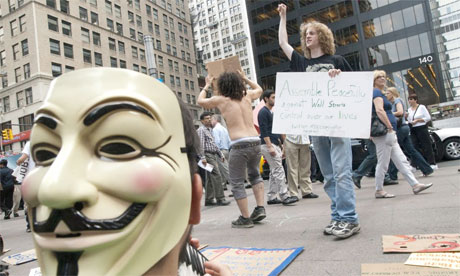November 5 is a special day in Britain, but the masks used for the occasion have gotten so popular this year they have become top-selling store items in Western countries. What’s up, que pasa, anyare?
My first reaction was that the mask is a very creepy mask: a man’s pale face with glowing pink cheeks, mustache and goatee, and an unnerving smile that’s almost like a leer. You wonder, “Where have I seen this mask before?” Then you suddenly realize. It’s those Guy Fawkes masks worn by growing ranks of demonstrators in American and European cities and that have come to symbolize Occupy Wall Street (OWS) protests.

But who is Guy Fawkes and how did he become a modern protest icon anyway? If you haven’t been a keen observant of the OWS phenomenon, you’re in for a surprising answer.
Fawkes was a 17th century English Catholic conspirator who joined a group that plotted to kill Protestant King James. The so-called Gunpowder Plot was discovered, and Fawkes was caught in flagrante delicto and tortured. He and several other conspirators were later tried and executed by the utterly civilized method of hanging, drawing and quartering. Every November 5 from 1605 until recently, the British would celebrate Guy Fawkes Night almost exactly the way we Filipinos celebrate New Year’s Eve—through a rowdy street celebration of bonfires, fireworks, and effigy burning.
Could one then fairly speculate that OWS protesters wearing Guy Fawkes masks since the Wall Street action began on September 17 are actually calling for something equally sinister or explosive? Maybe a gunpowder putsch to topple the government? Or perhaps city-wide street ruckuses like it was Guy Fawkes Night, but this time across the globe?
No, don’t be too quick to prejudge OWS that way. The message of the Guy Fawkes mask is more subtle than that. Get ready to be surprised.
There’s this imageboard website, 4chan.org, that’s incredibly popular among young computer and Internet culture enthusiasts. The site, set up in 2003 by a 15-year-old New York student, encouraged anonymous posting and swarming, and soon became a hotbed of hackers, online activists, and Internet meme creators.
At first, 4chan’s anonymous gimmicks were in the nature of online pranks, typically witty and whimsical but sometimes vicious, like gangs of youth looking for a cause and painting senseless graffiti on virtual walls. But from 2007 onwards, this anonymous community of hacktivists began to flex its muscles in hitting bigger targets—often mainstream institutions and personalities that earned the ire of rebellious youth—and in churning out lulz actions by spin-off hacker groups with names like Lulzsec and Anonymous.
These groups vandalized sites that they perceived to represent oppression and repression. They also directed their Internet actions to defend besieged online sites such as WikiLeaks and Pirate Bay. They idolized rebels, such as the hero of a 1980s comic book series, “V for Vendetta”, an anarchist revolutionary who dressed up and wore a mask that looked like—you guessed it right—Guy Fawkes.
Then the inevitable happened. Lulzsec and Anonymous began to get the attention of mainstream media, and their representatives, wearing business suits and Guy Fawkes masks, started to grant interviews. The media attention quickly shot up especially after July this year when they hacked sites affiliated with the FBI, CIA, and PayPal as part of their campaign to defend WikiLeaks personality Julian Assange.
On July 13, a Canada-based group, AdBusters, which maintained a blog and described themselves as “a global network of culture jammers and creatives working to change the way information flows, the way corporations wield power, and the way meaning is produced in our society,” called for all “redeemers, rebels and radicals out there” to occupy Wall Street starting on September 17.
On September 8, some Anons announced that they were supporting the OWS movement by using social media tactics, which included creating and publicly releasing a program that enabled online activists to massively generate Twitter messages (tweets) and ride on the “top trends” mechanism “to culture-jam your message into the public consciousness.”
OWS organizers and early supporters quickly caught on, and in a few days their tweets pushed #occupywallstreet messages to the top of the Twitter charts. Anons wearing Guy Fawkes masks were also among the first informal groups that camped on Wall Street on the first OWS day.
And so, as they say, the rest is history. But what a living, glowing, flowing, fast-moving history it has turned out to be.
I still don’t like the Guy Fawkes mask. As I said, it gives me the creeps. Given a choice, I’d rather have another iconic image, maybe that of a rebel heroine or the female dancer balanced atop the Wall Street bull, to symbolize the rapidly growing global protest movement started by OWS.
But, hey, the Guy Fawkes persona has deep historical roots too, and young hacktivists across the globe seem to be very fond of it. Like it or not, we will be seeing more of it in the next few days and weeks. So, with a clenched fist salute to express solidarity with the Occupy movement, let me greet everyone with a strangely familiar “Happy Guy Fawkes Day!” #


everyone assumes the poem is “from the movie” it was used in the film but it’s much, much older.
Thanks for the clarification, Kevin. A quick check via Google search shows that you’re right.